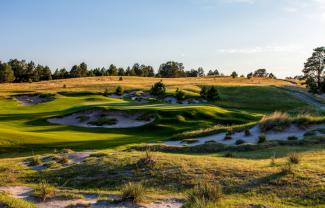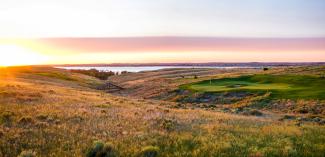Featured Golf News
More to Western Nebraska than Its Famed Sandhills Courses
Western Nebraska, the region past Kearney on the frontier of the Great Plains, is famously recognized for its Sandhills, the remnants of the retreat of vast oceans that covered parts of North America eons ago.

No. 9 Green at Pines Course at The Prairie Club
This area encompassing more than a quarter of the state features prairies of grass-stabilized sand dunes - land almost perfect for golf, especially links-style layouts more commonly found in coastal areas.
It's like finding Scotland in the middle of the United States and, without question, the most unique golfing terrain in the country - a sprawling, scrubby and desolate 20,000-square-mile expanse representing the largest area of sand dunes in all of America.
The land is well-suited for golf because of the varied topography, flora and fauna (with more than 700 species of plants and 300 animal species), and the sheer isolation of it all. You have to really want to get here.
Golf in the region was kick-started in 1995 by Ben Crenshaw and Bill Coore's "finding" of the course that became the fabled, private Sand Hills Golf Club. In subsequent years, a half-dozen other tracks have been built to highlight this naturally rolling terrain that boasts otherworldly vistas and lots of fun.

Wild Horse GC
Yet golf in western Nebraska is more that rollicking links and fairways rising and falling under endless horizons of swaying grasses atop and between massive dunes. There's a smattering of parkland-style venues as well, and even one that skirts a huge lake. This endearing combination helps make it a haven for great golf and a wonderful destination.
Wild Horse GC & Prairie Club Are Public Gems
Thirty minutes east of North Platte, just off I-80 in Gothenburg, is Wild Horse Golf Club, which many golfers consider a "poor-man's Sand Hills." Wild Horse has been called the "Carnoustie of the Corn Belt" (though it's much friendlier than Scotland's "Carnastie"). It was designed by Dave Proctor and Dave Axland, who assisted Coore and Crenshaw in building Sand Hills.
The course is unusual; a links-like landscape of sweeping dunes and nary a tree in sight. The routing is interrupted by cavernous bunkers, massive undulating greens and is framed by tall heather-like grasses.

The Approach to the 2nd Hole on the
Dunes Course at The Prairie Club
Wild Horse opened in 1998 and has been ranked by Golf Magazine as high as No. 67 on its list of the "Top 100 Courses You Can Play," and No. 58 on Golfweek's list of Best Modern Courses (opened after 1960).
Stretching 7,002 yards, Wild Horse has no water hazards, just tall prairie grasses along each hole and blow-out bunkers in strategic locations. The course has four short par-4s, which tempt players to go for broke on these wide fairways.
The steer skulls serving as 150-yard markers remind golfers that this tiny outpost in the middle of nowhere was once the gateway to the Wild West; en route to the course golfers drive by a historic Pony Express station, built in 1854. Wild Horse's highest rates are $66 per round, making it among the most affordable top-100 venues in the country.
The other top public (actually semiprivate) facility in Nebraska's Sandhills is The Prairie Club, set on the rim of the Snake River Canyon near Valentine. Debuting in 2010, the resort features a pair of regulation 18s, the Pines (designed by Graham Marsh) and the Dunes (by Tom Lehman and his lead associate, Chris Brands), as well as the Horse Course, a fun 10-hole par-3 by Gil Hanse that's without defined yardages and perfect for a casual knock-around outing.

No. 4 Green at Dunes Course at the Prairie Club
The Pines is integrated into open prairie and a ponderosa forest adjacent to the Snake River. The challenge is defined by its greens' subtle movements and occasional wavier surfaces. The course plays to a par of 73 and 7,403 yards.
Here, you'll find blind and semi-blind shots from a handful of the back tees. Drives are played to fairways that are mostly generous but not excessively so, which adds an ingredient of control while not overly penal even in high winds.
Despite the overall quality of the Pines, it's the Dunes Course that steals the show. The architects, who spent 16 months identifying 18 holes out of "hundreds" they could have selected, combined huge dunes with similarly sized fairways.
The radical width disguises how intricate a design the Dunes really is, though. There are times when a hole with a 100-yard-wide fairway has an optimal line of play that's actually over the rough.
From the tips, the par-73 layout extends 7,583 yards. It's by far the most expansive golf course I've ever played, providing a compelling round from the first tee shot to the final putt with its inspired bunkering, sheer scale and brilliant greens. There are so many sets of tees, possible pin locations and cleverly placed bunkers (amid a constantly switching wind) that give the course a different feel every time it's played.
The Dunes ranks No. 78 on Golf's top-100 American public courses. Virtually treeless and without a single water hazard or forced carry, it boasts firm-and-fast conditions. The staff estimates that the wind blows an average of 20 mph here every day, so it's no wonder the Dunes tends to blow golfers away, literally and figuratively.

Heritage Hills GC
Great Golf off the Sandhills
On our way into the Sandhills from Denver, we stopped in McCook and played Heritage Hills Golf Club, a fine parkland layout and a hearty challenge despite the fact that it stretches just 6,715 from the back tees.
Opened in 1981 and designed by Bradford Benz and Richard Phelps, Heritage Hills offers an up-and-down experience as most holes begin and end with elevated tees and putting surfaces. The wind plays a major factor in how tough the course can be on any given day, but it seems the breezes are always aloft, so take one more club and hold on.
Heritage Hill's lush fairways are bordered by native grasses that place an emphasis on shot placement and making smart approach shots into some fast and tricky greens.

Bayside Golf Club
On our way out of Western Nebraska, we spent a day in Brule and teed it up at Bayside Golf Club, the course that was the biggest surprise of our trip. Bayside is well off the beaten path and is as natural as golf can be. It's a rustic links design by Axland and Proctor (the same guys that "found" Wild Horse) and borders the Cornhusker State's largest water body, Lake McConaughy.
The routing is over rugged terrain pocked with arroyos, ruts, bluffs and native grassland, making it more target golf than any other course we played. The designers embraced the site and gave each hole into its own personality, creating a rollercoaster of twists and turns and a test from shot to shot.
Par-72 Bayside plays at 6,597 from the tips, and offers two distinct nine-hole sides. The front half is flatter and more forgiving, giving players an opportunity to start a round on a positive note. But the home half has more forced carries and tougher approaches. Players will never forget the par-5 11th, an imposing 648 yarder and the longest hole in the great state of Nebraska. It also features 28 bunkers and a difficult lay-up and approach to a Cape green.
I enjoyed my round with Cliff Brown, the course owner and developer. His insider knowledge of the course and its tricky strategies was invaluable in giving me an exciting and rewarding experience; but that insight still didn't make things any easier. Bayside Golf Club was rated a four-star course by Golf Digest and has been lauded as the No. 2 public-access course in Nebraska by Golfweek.
For more information about these courses, visit www.playwildhorse.com, www.theprairieclub.com, www.heritagehillsmccook.com, and www.baysidegolf.com.
Steve Habel is a freelance writer contributing Cybergolf news stories, features, equipment and book reviews and personality profiles from his base in Austin, Texas. He also works as an associate editor for Horns Illustrated magazine, a publication focusing on University of Texas sports, and is a contributing writer for Texas Golf Insider, Golf Oklahoma magazine, Tri-State Golfer and ATX Man magazine. Habel's blog (www.shotoverthegreen.blogspot.com) features news on golf and chronicles his many travels, including playing almost 1,000 golf courses since 2008. Habel is a member of the Golf Writers Association of America and the Texas Golf Writers Association.
Story Options
 |
Print this Story |
